Comprehensive Report: Understanding and Managing Child Aggression
VerifiedAdded on 2021/06/17
|11
|2355
|144
Report
AI Summary
This report examines aggressive behavior in children, addressing causes such as family issues, school problems, and personal factors like autism and psychological health. It details symptoms including physical violence, social isolation, and emotional mood swings, along with implications such as personal disorders and suicidal thoughts. The report emphasizes early intervention and inclusive teaching strategies, advocating for parent training, positive classroom settings, and color therapy to manage aggression. It suggests rewarding good behavior, providing alternative outlets for anger, and creating a supportive environment at home and school. The conclusion highlights the importance of treating children with respect and love to regulate their behavior effectively. The report includes an extensive list of references supporting the findings and recommendations.
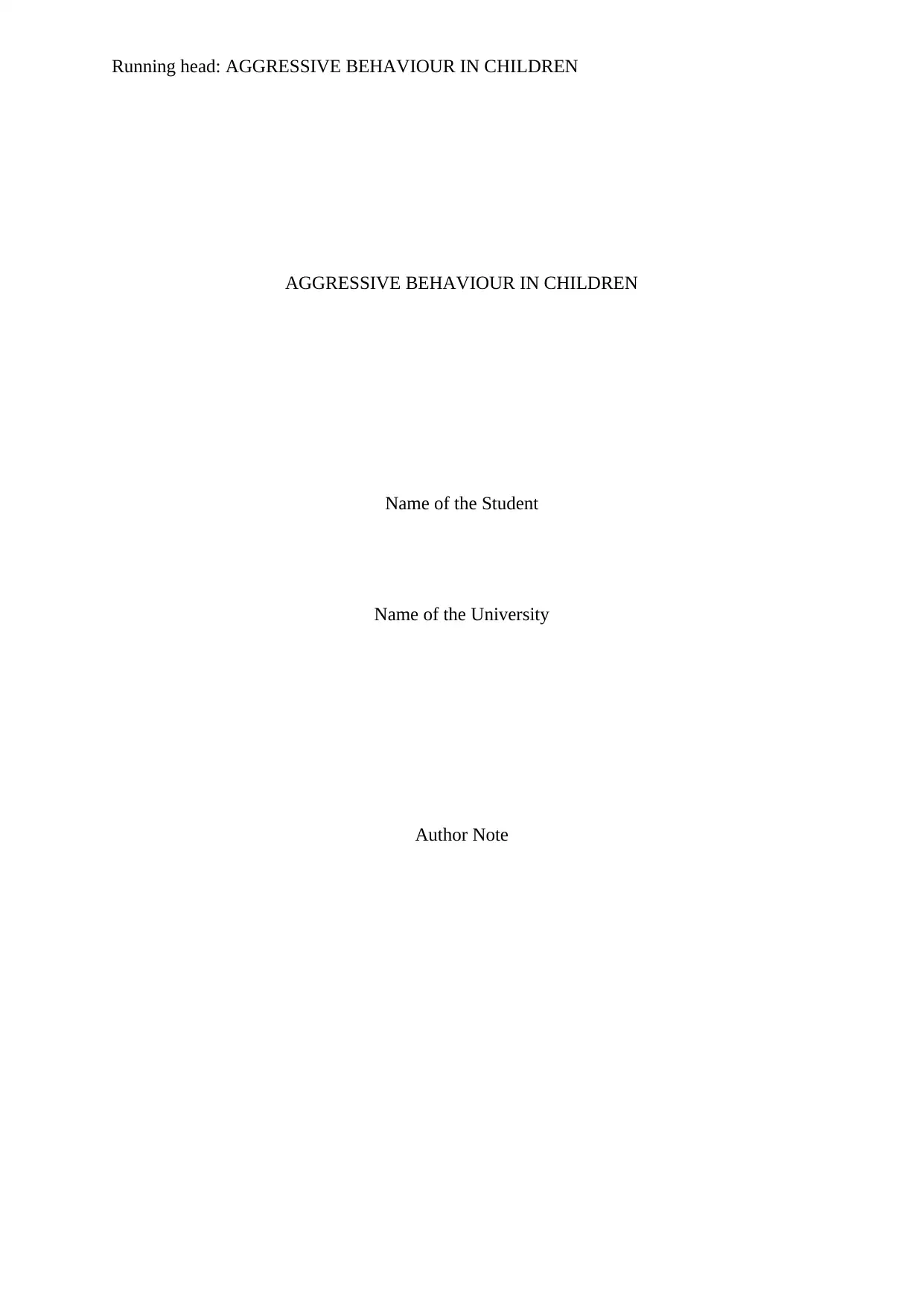
Running head: AGGRESSIVE BEHAVIOUR IN CHILDREN
AGGRESSIVE BEHAVIOUR IN CHILDREN
Name of the Student
Name of the University
Author Note
AGGRESSIVE BEHAVIOUR IN CHILDREN
Name of the Student
Name of the University
Author Note
Paraphrase This Document
Need a fresh take? Get an instant paraphrase of this document with our AI Paraphraser
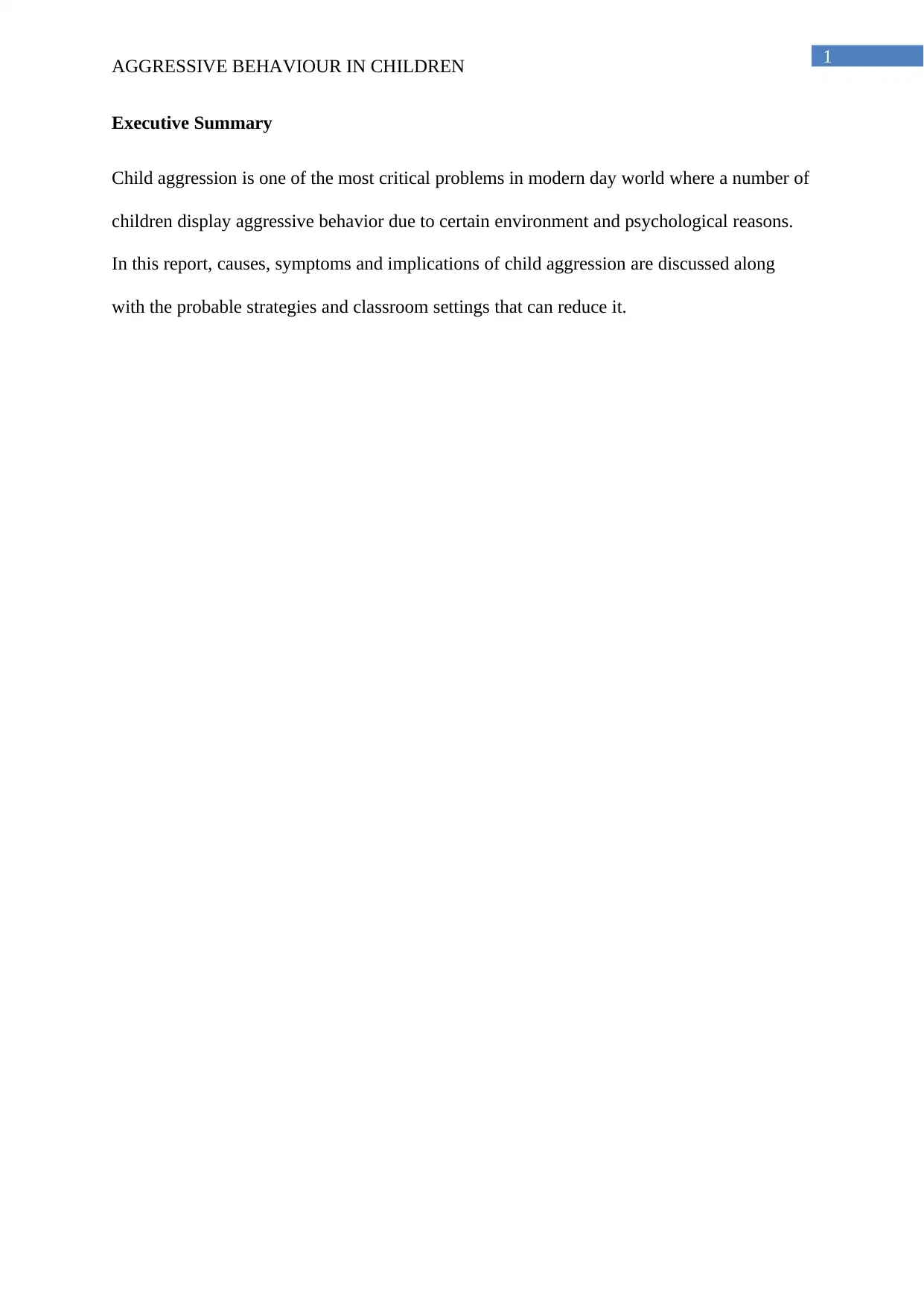
1
AGGRESSIVE BEHAVIOUR IN CHILDREN
Executive Summary
Child aggression is one of the most critical problems in modern day world where a number of
children display aggressive behavior due to certain environment and psychological reasons.
In this report, causes, symptoms and implications of child aggression are discussed along
with the probable strategies and classroom settings that can reduce it.
AGGRESSIVE BEHAVIOUR IN CHILDREN
Executive Summary
Child aggression is one of the most critical problems in modern day world where a number of
children display aggressive behavior due to certain environment and psychological reasons.
In this report, causes, symptoms and implications of child aggression are discussed along
with the probable strategies and classroom settings that can reduce it.
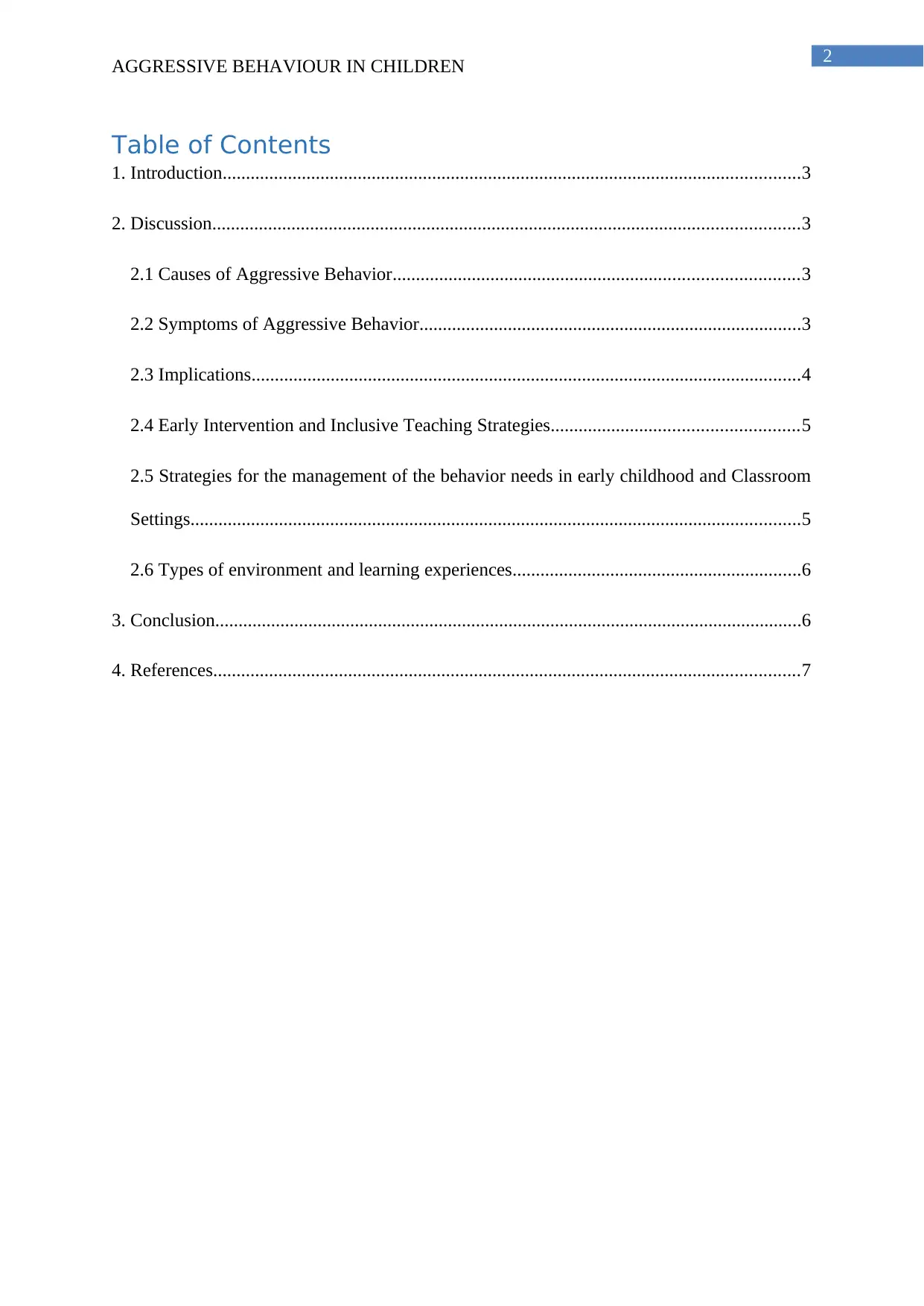
2
AGGRESSIVE BEHAVIOUR IN CHILDREN
Table of Contents
1. Introduction............................................................................................................................3
2. Discussion..............................................................................................................................3
2.1 Causes of Aggressive Behavior.......................................................................................3
2.2 Symptoms of Aggressive Behavior..................................................................................3
2.3 Implications......................................................................................................................4
2.4 Early Intervention and Inclusive Teaching Strategies.....................................................5
2.5 Strategies for the management of the behavior needs in early childhood and Classroom
Settings...................................................................................................................................5
2.6 Types of environment and learning experiences..............................................................6
3. Conclusion..............................................................................................................................6
4. References..............................................................................................................................7
AGGRESSIVE BEHAVIOUR IN CHILDREN
Table of Contents
1. Introduction............................................................................................................................3
2. Discussion..............................................................................................................................3
2.1 Causes of Aggressive Behavior.......................................................................................3
2.2 Symptoms of Aggressive Behavior..................................................................................3
2.3 Implications......................................................................................................................4
2.4 Early Intervention and Inclusive Teaching Strategies.....................................................5
2.5 Strategies for the management of the behavior needs in early childhood and Classroom
Settings...................................................................................................................................5
2.6 Types of environment and learning experiences..............................................................6
3. Conclusion..............................................................................................................................6
4. References..............................................................................................................................7
⊘ This is a preview!⊘
Do you want full access?
Subscribe today to unlock all pages.

Trusted by 1+ million students worldwide
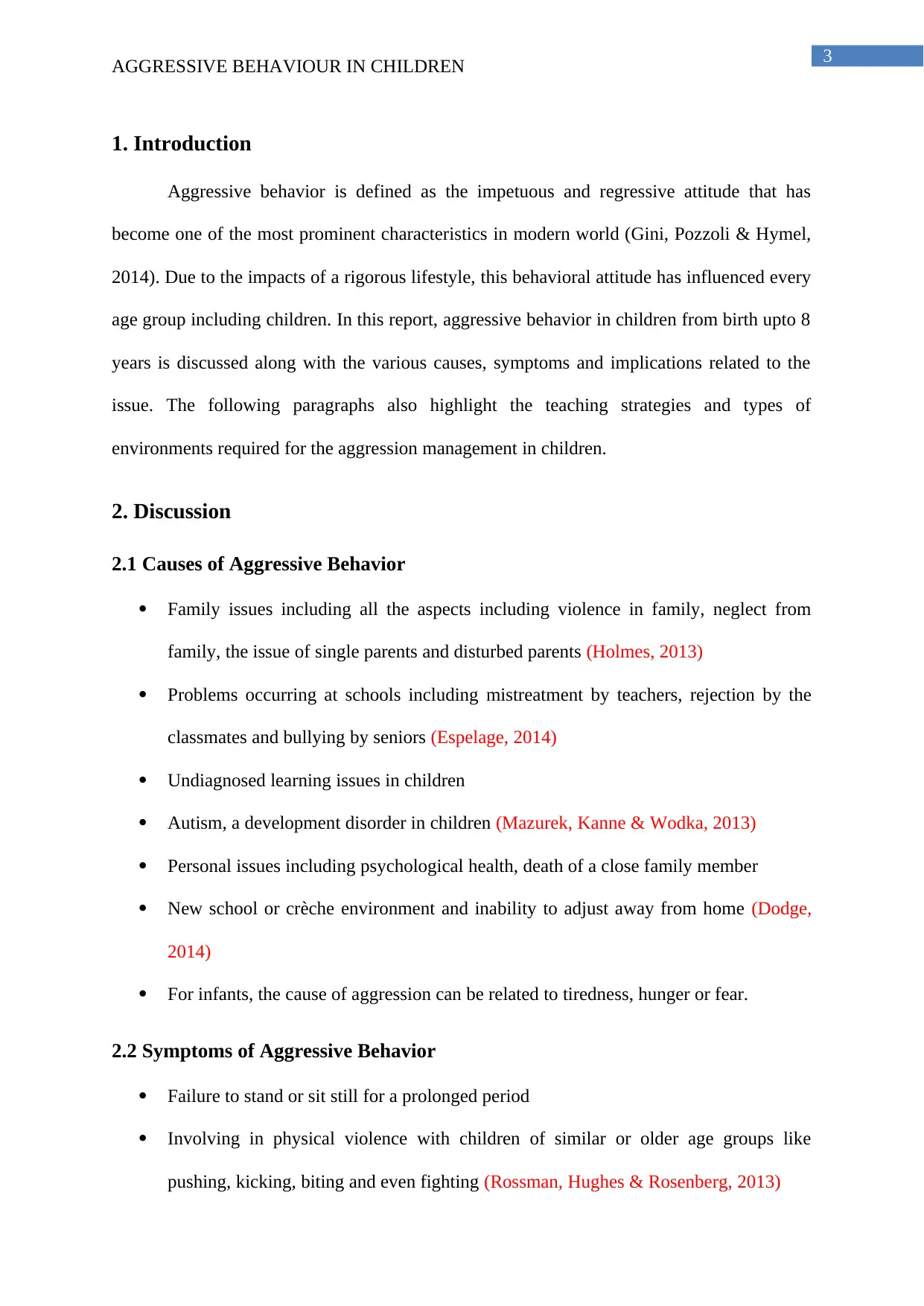
3
AGGRESSIVE BEHAVIOUR IN CHILDREN
1. Introduction
Aggressive behavior is defined as the impetuous and regressive attitude that has
become one of the most prominent characteristics in modern world (Gini, Pozzoli & Hymel,
2014). Due to the impacts of a rigorous lifestyle, this behavioral attitude has influenced every
age group including children. In this report, aggressive behavior in children from birth upto 8
years is discussed along with the various causes, symptoms and implications related to the
issue. The following paragraphs also highlight the teaching strategies and types of
environments required for the aggression management in children.
2. Discussion
2.1 Causes of Aggressive Behavior
Family issues including all the aspects including violence in family, neglect from
family, the issue of single parents and disturbed parents (Holmes, 2013)
Problems occurring at schools including mistreatment by teachers, rejection by the
classmates and bullying by seniors (Espelage, 2014)
Undiagnosed learning issues in children
Autism, a development disorder in children (Mazurek, Kanne & Wodka, 2013)
Personal issues including psychological health, death of a close family member
New school or crèche environment and inability to adjust away from home (Dodge,
2014)
For infants, the cause of aggression can be related to tiredness, hunger or fear.
2.2 Symptoms of Aggressive Behavior
Failure to stand or sit still for a prolonged period
Involving in physical violence with children of similar or older age groups like
pushing, kicking, biting and even fighting (Rossman, Hughes & Rosenberg, 2013)
AGGRESSIVE BEHAVIOUR IN CHILDREN
1. Introduction
Aggressive behavior is defined as the impetuous and regressive attitude that has
become one of the most prominent characteristics in modern world (Gini, Pozzoli & Hymel,
2014). Due to the impacts of a rigorous lifestyle, this behavioral attitude has influenced every
age group including children. In this report, aggressive behavior in children from birth upto 8
years is discussed along with the various causes, symptoms and implications related to the
issue. The following paragraphs also highlight the teaching strategies and types of
environments required for the aggression management in children.
2. Discussion
2.1 Causes of Aggressive Behavior
Family issues including all the aspects including violence in family, neglect from
family, the issue of single parents and disturbed parents (Holmes, 2013)
Problems occurring at schools including mistreatment by teachers, rejection by the
classmates and bullying by seniors (Espelage, 2014)
Undiagnosed learning issues in children
Autism, a development disorder in children (Mazurek, Kanne & Wodka, 2013)
Personal issues including psychological health, death of a close family member
New school or crèche environment and inability to adjust away from home (Dodge,
2014)
For infants, the cause of aggression can be related to tiredness, hunger or fear.
2.2 Symptoms of Aggressive Behavior
Failure to stand or sit still for a prolonged period
Involving in physical violence with children of similar or older age groups like
pushing, kicking, biting and even fighting (Rossman, Hughes & Rosenberg, 2013)
Paraphrase This Document
Need a fresh take? Get an instant paraphrase of this document with our AI Paraphraser
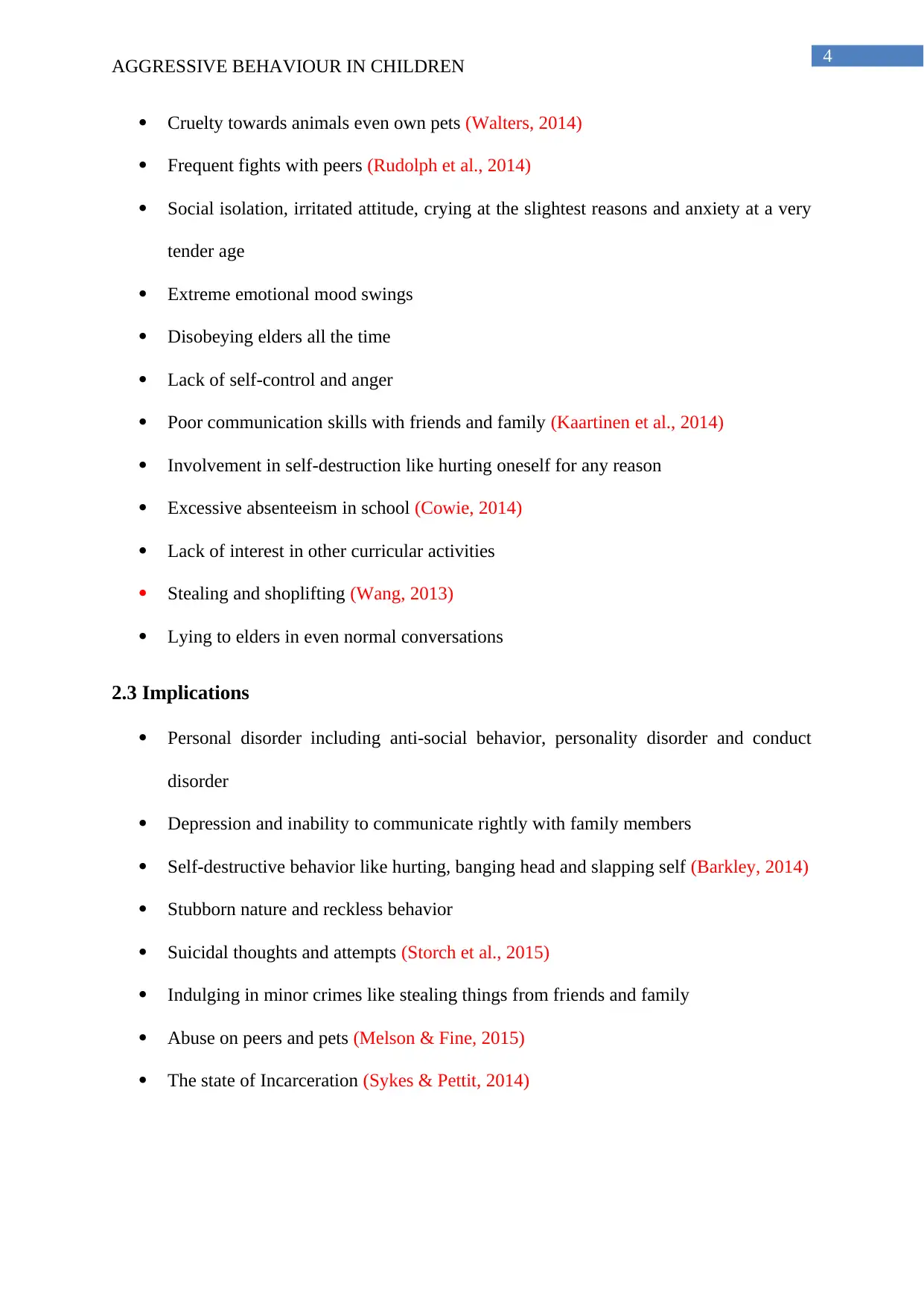
4
AGGRESSIVE BEHAVIOUR IN CHILDREN
Cruelty towards animals even own pets (Walters, 2014)
Frequent fights with peers (Rudolph et al., 2014)
Social isolation, irritated attitude, crying at the slightest reasons and anxiety at a very
tender age
Extreme emotional mood swings
Disobeying elders all the time
Lack of self-control and anger
Poor communication skills with friends and family (Kaartinen et al., 2014)
Involvement in self-destruction like hurting oneself for any reason
Excessive absenteeism in school (Cowie, 2014)
Lack of interest in other curricular activities
Stealing and shoplifting (Wang, 2013)
Lying to elders in even normal conversations
2.3 Implications
Personal disorder including anti-social behavior, personality disorder and conduct
disorder
Depression and inability to communicate rightly with family members
Self-destructive behavior like hurting, banging head and slapping self (Barkley, 2014)
Stubborn nature and reckless behavior
Suicidal thoughts and attempts (Storch et al., 2015)
Indulging in minor crimes like stealing things from friends and family
Abuse on peers and pets (Melson & Fine, 2015)
The state of Incarceration (Sykes & Pettit, 2014)
AGGRESSIVE BEHAVIOUR IN CHILDREN
Cruelty towards animals even own pets (Walters, 2014)
Frequent fights with peers (Rudolph et al., 2014)
Social isolation, irritated attitude, crying at the slightest reasons and anxiety at a very
tender age
Extreme emotional mood swings
Disobeying elders all the time
Lack of self-control and anger
Poor communication skills with friends and family (Kaartinen et al., 2014)
Involvement in self-destruction like hurting oneself for any reason
Excessive absenteeism in school (Cowie, 2014)
Lack of interest in other curricular activities
Stealing and shoplifting (Wang, 2013)
Lying to elders in even normal conversations
2.3 Implications
Personal disorder including anti-social behavior, personality disorder and conduct
disorder
Depression and inability to communicate rightly with family members
Self-destructive behavior like hurting, banging head and slapping self (Barkley, 2014)
Stubborn nature and reckless behavior
Suicidal thoughts and attempts (Storch et al., 2015)
Indulging in minor crimes like stealing things from friends and family
Abuse on peers and pets (Melson & Fine, 2015)
The state of Incarceration (Sykes & Pettit, 2014)
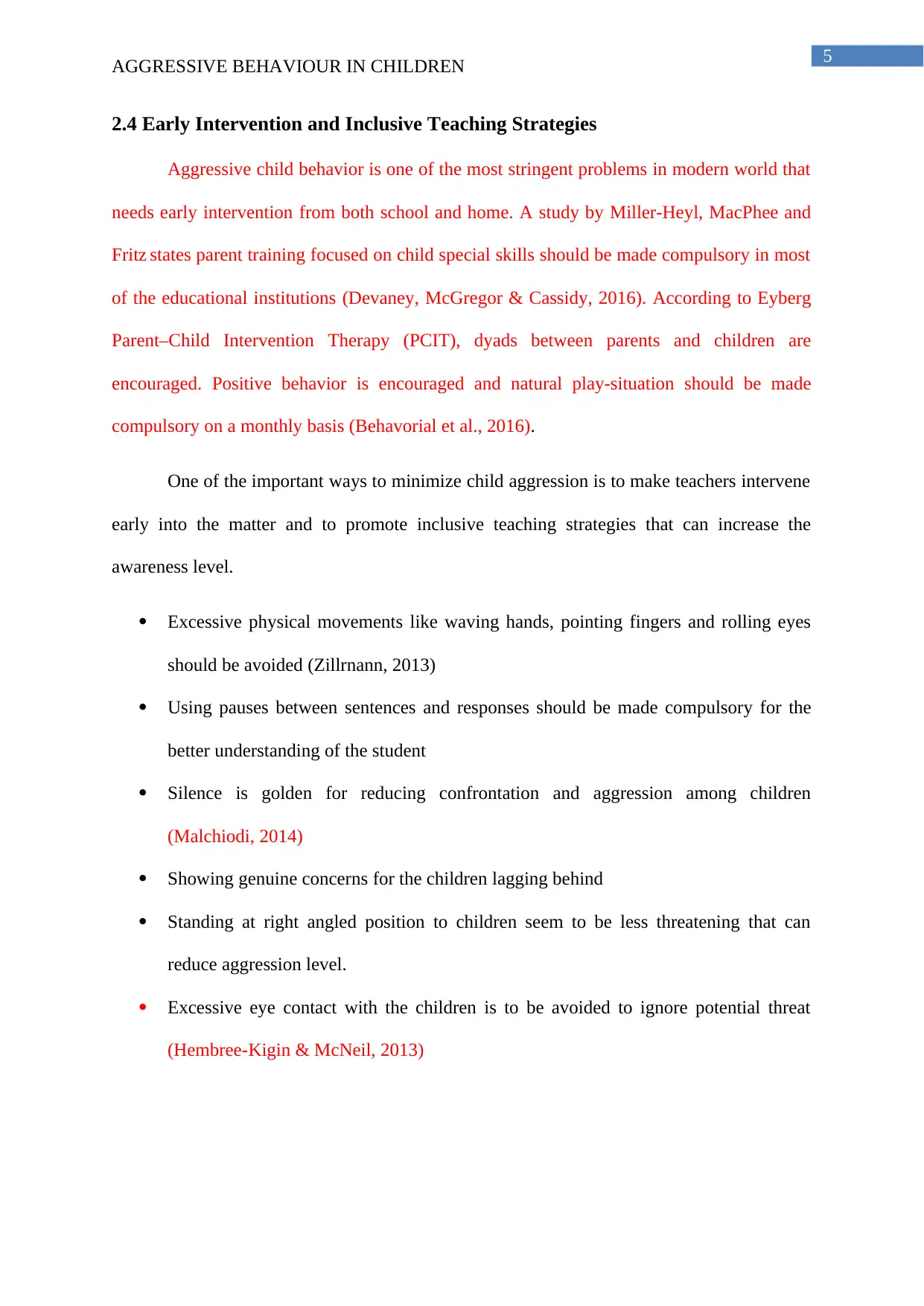
5
AGGRESSIVE BEHAVIOUR IN CHILDREN
2.4 Early Intervention and Inclusive Teaching Strategies
Aggressive child behavior is one of the most stringent problems in modern world that
needs early intervention from both school and home. A study by Miller-Heyl, MacPhee and
Fritz states parent training focused on child special skills should be made compulsory in most
of the educational institutions (Devaney, McGregor & Cassidy, 2016). According to Eyberg
Parent–Child Intervention Therapy (PCIT), dyads between parents and children are
encouraged. Positive behavior is encouraged and natural play-situation should be made
compulsory on a monthly basis (Behavorial et al., 2016).
One of the important ways to minimize child aggression is to make teachers intervene
early into the matter and to promote inclusive teaching strategies that can increase the
awareness level.
Excessive physical movements like waving hands, pointing fingers and rolling eyes
should be avoided (Zillrnann, 2013)
Using pauses between sentences and responses should be made compulsory for the
better understanding of the student
Silence is golden for reducing confrontation and aggression among children
(Malchiodi, 2014)
Showing genuine concerns for the children lagging behind
Standing at right angled position to children seem to be less threatening that can
reduce aggression level.
Excessive eye contact with the children is to be avoided to ignore potential threat
(Hembree-Kigin & McNeil, 2013)
AGGRESSIVE BEHAVIOUR IN CHILDREN
2.4 Early Intervention and Inclusive Teaching Strategies
Aggressive child behavior is one of the most stringent problems in modern world that
needs early intervention from both school and home. A study by Miller-Heyl, MacPhee and
Fritz states parent training focused on child special skills should be made compulsory in most
of the educational institutions (Devaney, McGregor & Cassidy, 2016). According to Eyberg
Parent–Child Intervention Therapy (PCIT), dyads between parents and children are
encouraged. Positive behavior is encouraged and natural play-situation should be made
compulsory on a monthly basis (Behavorial et al., 2016).
One of the important ways to minimize child aggression is to make teachers intervene
early into the matter and to promote inclusive teaching strategies that can increase the
awareness level.
Excessive physical movements like waving hands, pointing fingers and rolling eyes
should be avoided (Zillrnann, 2013)
Using pauses between sentences and responses should be made compulsory for the
better understanding of the student
Silence is golden for reducing confrontation and aggression among children
(Malchiodi, 2014)
Showing genuine concerns for the children lagging behind
Standing at right angled position to children seem to be less threatening that can
reduce aggression level.
Excessive eye contact with the children is to be avoided to ignore potential threat
(Hembree-Kigin & McNeil, 2013)
⊘ This is a preview!⊘
Do you want full access?
Subscribe today to unlock all pages.

Trusted by 1+ million students worldwide
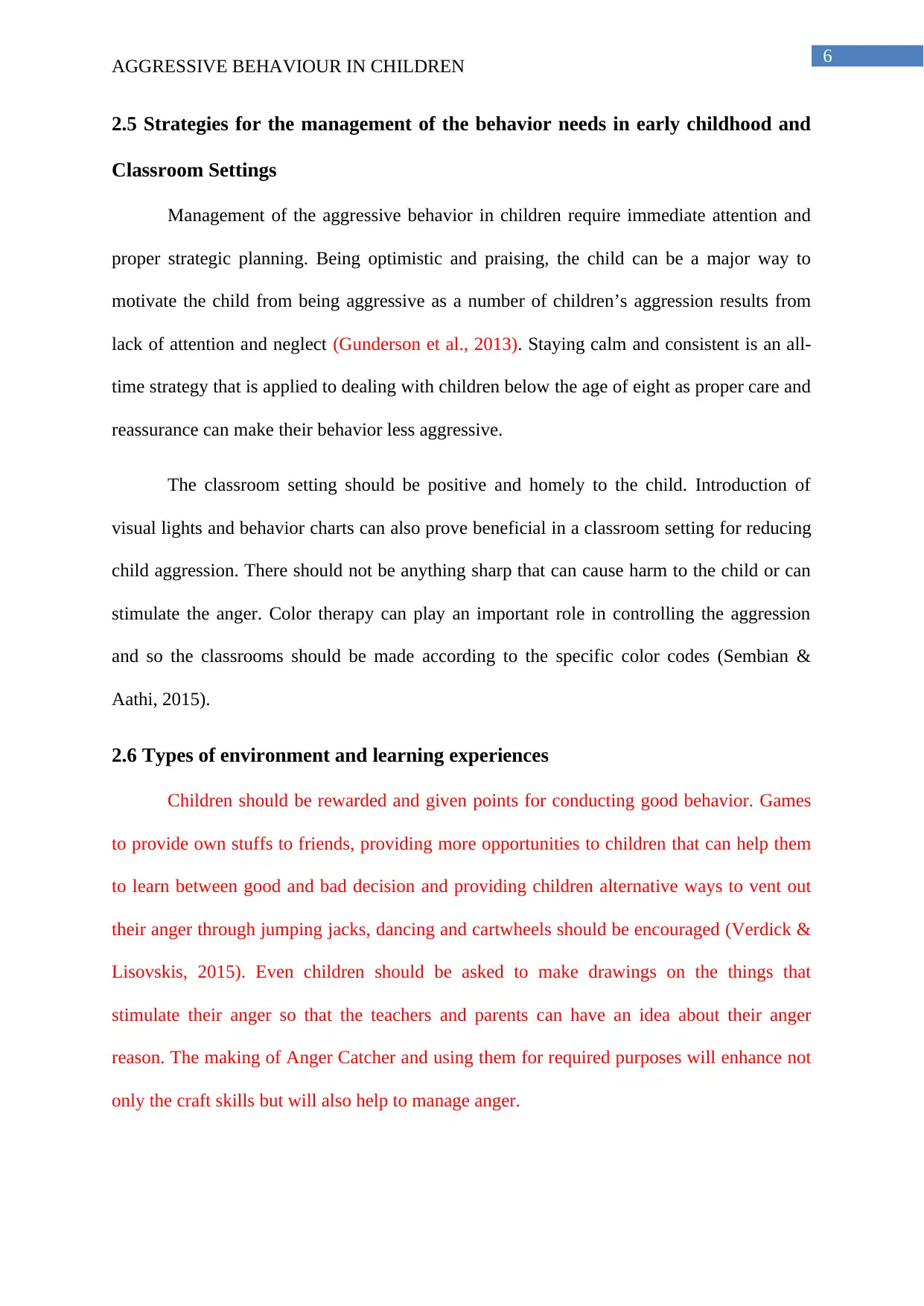
6
AGGRESSIVE BEHAVIOUR IN CHILDREN
2.5 Strategies for the management of the behavior needs in early childhood and
Classroom Settings
Management of the aggressive behavior in children require immediate attention and
proper strategic planning. Being optimistic and praising, the child can be a major way to
motivate the child from being aggressive as a number of children’s aggression results from
lack of attention and neglect (Gunderson et al., 2013). Staying calm and consistent is an all-
time strategy that is applied to dealing with children below the age of eight as proper care and
reassurance can make their behavior less aggressive.
The classroom setting should be positive and homely to the child. Introduction of
visual lights and behavior charts can also prove beneficial in a classroom setting for reducing
child aggression. There should not be anything sharp that can cause harm to the child or can
stimulate the anger. Color therapy can play an important role in controlling the aggression
and so the classrooms should be made according to the specific color codes (Sembian &
Aathi, 2015).
2.6 Types of environment and learning experiences
Children should be rewarded and given points for conducting good behavior. Games
to provide own stuffs to friends, providing more opportunities to children that can help them
to learn between good and bad decision and providing children alternative ways to vent out
their anger through jumping jacks, dancing and cartwheels should be encouraged (Verdick &
Lisovskis, 2015). Even children should be asked to make drawings on the things that
stimulate their anger so that the teachers and parents can have an idea about their anger
reason. The making of Anger Catcher and using them for required purposes will enhance not
only the craft skills but will also help to manage anger.
AGGRESSIVE BEHAVIOUR IN CHILDREN
2.5 Strategies for the management of the behavior needs in early childhood and
Classroom Settings
Management of the aggressive behavior in children require immediate attention and
proper strategic planning. Being optimistic and praising, the child can be a major way to
motivate the child from being aggressive as a number of children’s aggression results from
lack of attention and neglect (Gunderson et al., 2013). Staying calm and consistent is an all-
time strategy that is applied to dealing with children below the age of eight as proper care and
reassurance can make their behavior less aggressive.
The classroom setting should be positive and homely to the child. Introduction of
visual lights and behavior charts can also prove beneficial in a classroom setting for reducing
child aggression. There should not be anything sharp that can cause harm to the child or can
stimulate the anger. Color therapy can play an important role in controlling the aggression
and so the classrooms should be made according to the specific color codes (Sembian &
Aathi, 2015).
2.6 Types of environment and learning experiences
Children should be rewarded and given points for conducting good behavior. Games
to provide own stuffs to friends, providing more opportunities to children that can help them
to learn between good and bad decision and providing children alternative ways to vent out
their anger through jumping jacks, dancing and cartwheels should be encouraged (Verdick &
Lisovskis, 2015). Even children should be asked to make drawings on the things that
stimulate their anger so that the teachers and parents can have an idea about their anger
reason. The making of Anger Catcher and using them for required purposes will enhance not
only the craft skills but will also help to manage anger.
Paraphrase This Document
Need a fresh take? Get an instant paraphrase of this document with our AI Paraphraser
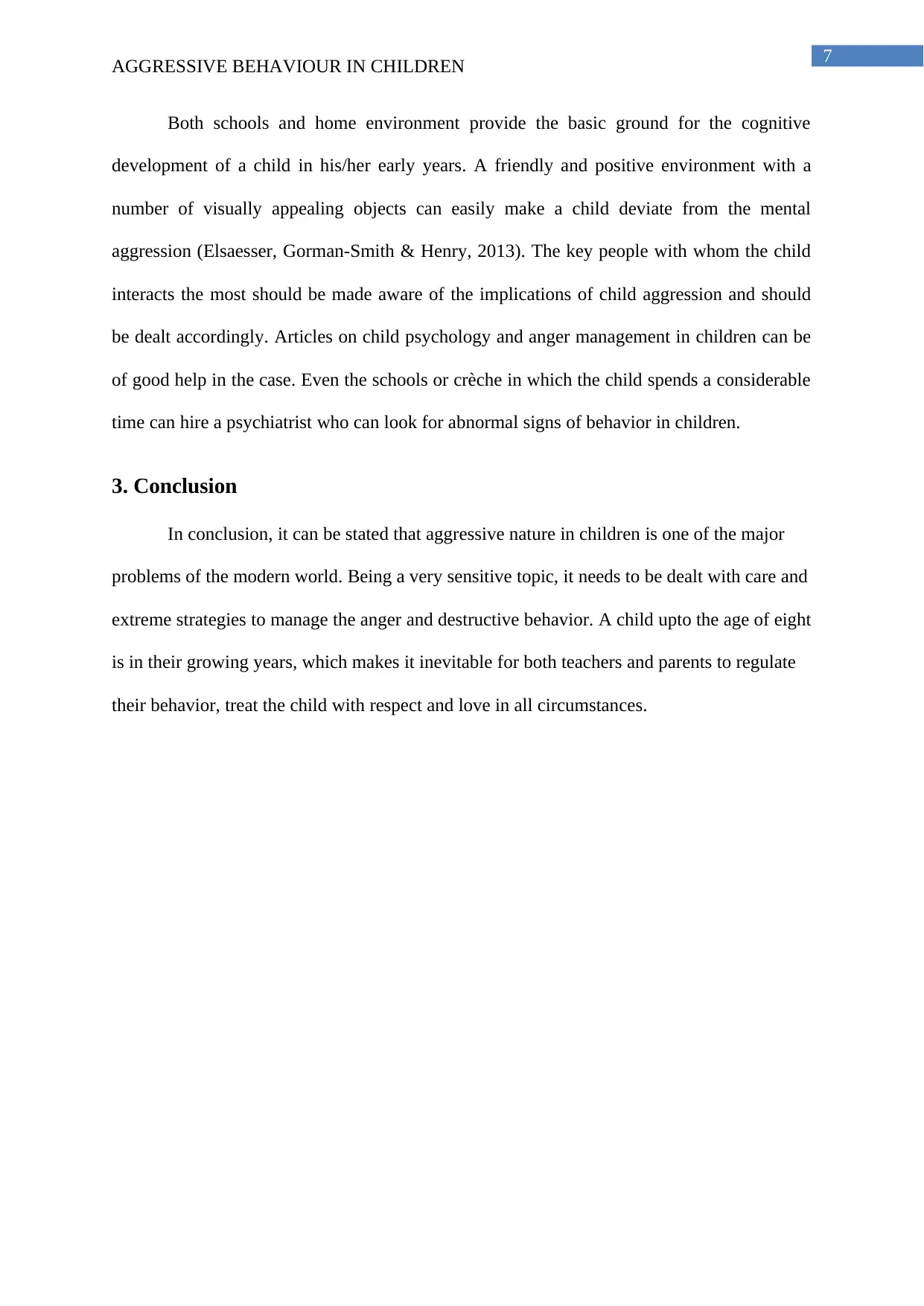
7
AGGRESSIVE BEHAVIOUR IN CHILDREN
Both schools and home environment provide the basic ground for the cognitive
development of a child in his/her early years. A friendly and positive environment with a
number of visually appealing objects can easily make a child deviate from the mental
aggression (Elsaesser, Gorman-Smith & Henry, 2013). The key people with whom the child
interacts the most should be made aware of the implications of child aggression and should
be dealt accordingly. Articles on child psychology and anger management in children can be
of good help in the case. Even the schools or crèche in which the child spends a considerable
time can hire a psychiatrist who can look for abnormal signs of behavior in children.
3. Conclusion
In conclusion, it can be stated that aggressive nature in children is one of the major
problems of the modern world. Being a very sensitive topic, it needs to be dealt with care and
extreme strategies to manage the anger and destructive behavior. A child upto the age of eight
is in their growing years, which makes it inevitable for both teachers and parents to regulate
their behavior, treat the child with respect and love in all circumstances.
AGGRESSIVE BEHAVIOUR IN CHILDREN
Both schools and home environment provide the basic ground for the cognitive
development of a child in his/her early years. A friendly and positive environment with a
number of visually appealing objects can easily make a child deviate from the mental
aggression (Elsaesser, Gorman-Smith & Henry, 2013). The key people with whom the child
interacts the most should be made aware of the implications of child aggression and should
be dealt accordingly. Articles on child psychology and anger management in children can be
of good help in the case. Even the schools or crèche in which the child spends a considerable
time can hire a psychiatrist who can look for abnormal signs of behavior in children.
3. Conclusion
In conclusion, it can be stated that aggressive nature in children is one of the major
problems of the modern world. Being a very sensitive topic, it needs to be dealt with care and
extreme strategies to manage the anger and destructive behavior. A child upto the age of eight
is in their growing years, which makes it inevitable for both teachers and parents to regulate
their behavior, treat the child with respect and love in all circumstances.
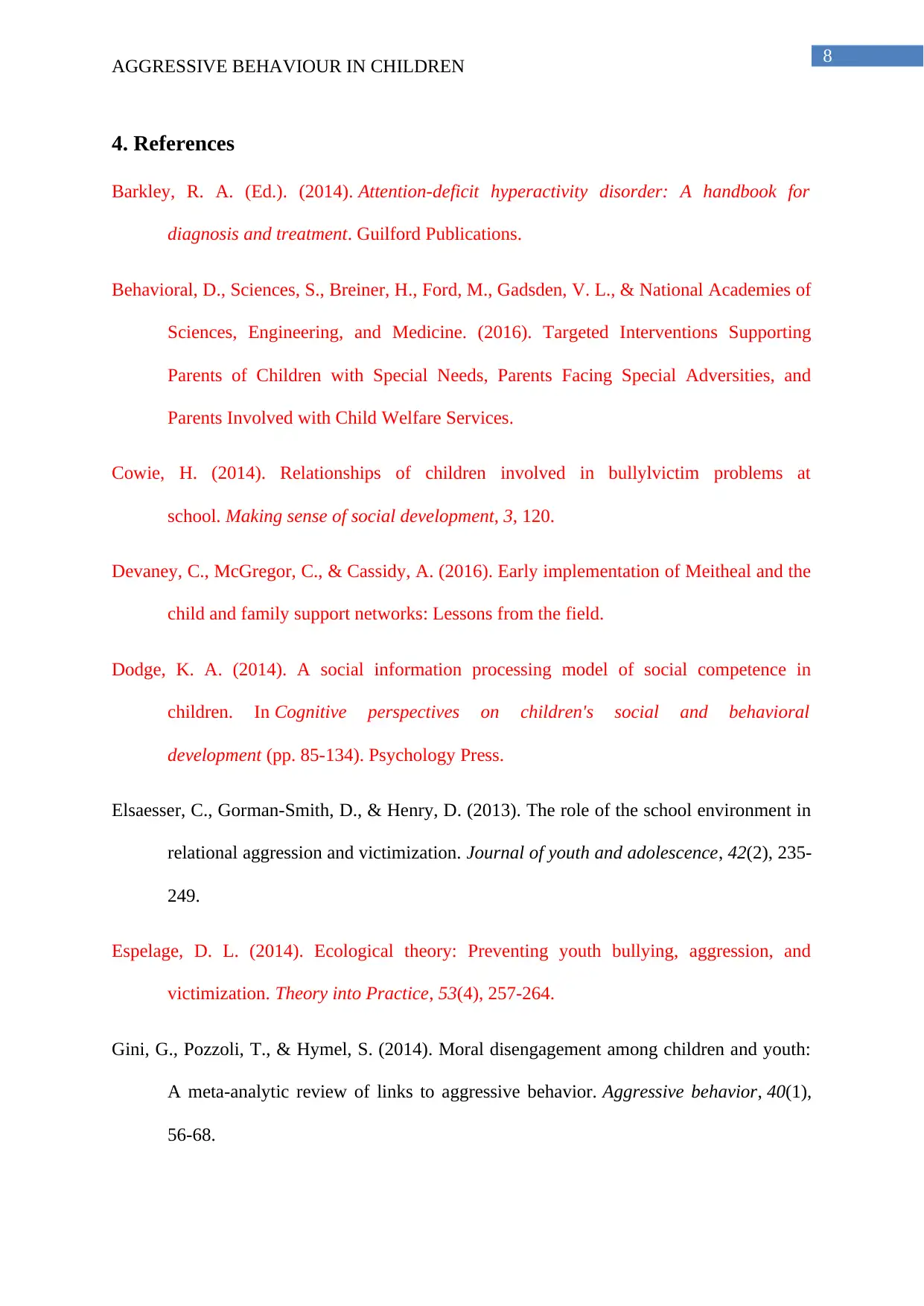
8
AGGRESSIVE BEHAVIOUR IN CHILDREN
4. References
Barkley, R. A. (Ed.). (2014). Attention-deficit hyperactivity disorder: A handbook for
diagnosis and treatment. Guilford Publications.
Behavioral, D., Sciences, S., Breiner, H., Ford, M., Gadsden, V. L., & National Academies of
Sciences, Engineering, and Medicine. (2016). Targeted Interventions Supporting
Parents of Children with Special Needs, Parents Facing Special Adversities, and
Parents Involved with Child Welfare Services.
Cowie, H. (2014). Relationships of children involved in bullylvictim problems at
school. Making sense of social development, 3, 120.
Devaney, C., McGregor, C., & Cassidy, A. (2016). Early implementation of Meitheal and the
child and family support networks: Lessons from the field.
Dodge, K. A. (2014). A social information processing model of social competence in
children. In Cognitive perspectives on children's social and behavioral
development (pp. 85-134). Psychology Press.
Elsaesser, C., Gorman-Smith, D., & Henry, D. (2013). The role of the school environment in
relational aggression and victimization. Journal of youth and adolescence, 42(2), 235-
249.
Espelage, D. L. (2014). Ecological theory: Preventing youth bullying, aggression, and
victimization. Theory into Practice, 53(4), 257-264.
Gini, G., Pozzoli, T., & Hymel, S. (2014). Moral disengagement among children and youth:
A meta‐analytic review of links to aggressive behavior. Aggressive behavior, 40(1),
56-68.
AGGRESSIVE BEHAVIOUR IN CHILDREN
4. References
Barkley, R. A. (Ed.). (2014). Attention-deficit hyperactivity disorder: A handbook for
diagnosis and treatment. Guilford Publications.
Behavioral, D., Sciences, S., Breiner, H., Ford, M., Gadsden, V. L., & National Academies of
Sciences, Engineering, and Medicine. (2016). Targeted Interventions Supporting
Parents of Children with Special Needs, Parents Facing Special Adversities, and
Parents Involved with Child Welfare Services.
Cowie, H. (2014). Relationships of children involved in bullylvictim problems at
school. Making sense of social development, 3, 120.
Devaney, C., McGregor, C., & Cassidy, A. (2016). Early implementation of Meitheal and the
child and family support networks: Lessons from the field.
Dodge, K. A. (2014). A social information processing model of social competence in
children. In Cognitive perspectives on children's social and behavioral
development (pp. 85-134). Psychology Press.
Elsaesser, C., Gorman-Smith, D., & Henry, D. (2013). The role of the school environment in
relational aggression and victimization. Journal of youth and adolescence, 42(2), 235-
249.
Espelage, D. L. (2014). Ecological theory: Preventing youth bullying, aggression, and
victimization. Theory into Practice, 53(4), 257-264.
Gini, G., Pozzoli, T., & Hymel, S. (2014). Moral disengagement among children and youth:
A meta‐analytic review of links to aggressive behavior. Aggressive behavior, 40(1),
56-68.
⊘ This is a preview!⊘
Do you want full access?
Subscribe today to unlock all pages.

Trusted by 1+ million students worldwide
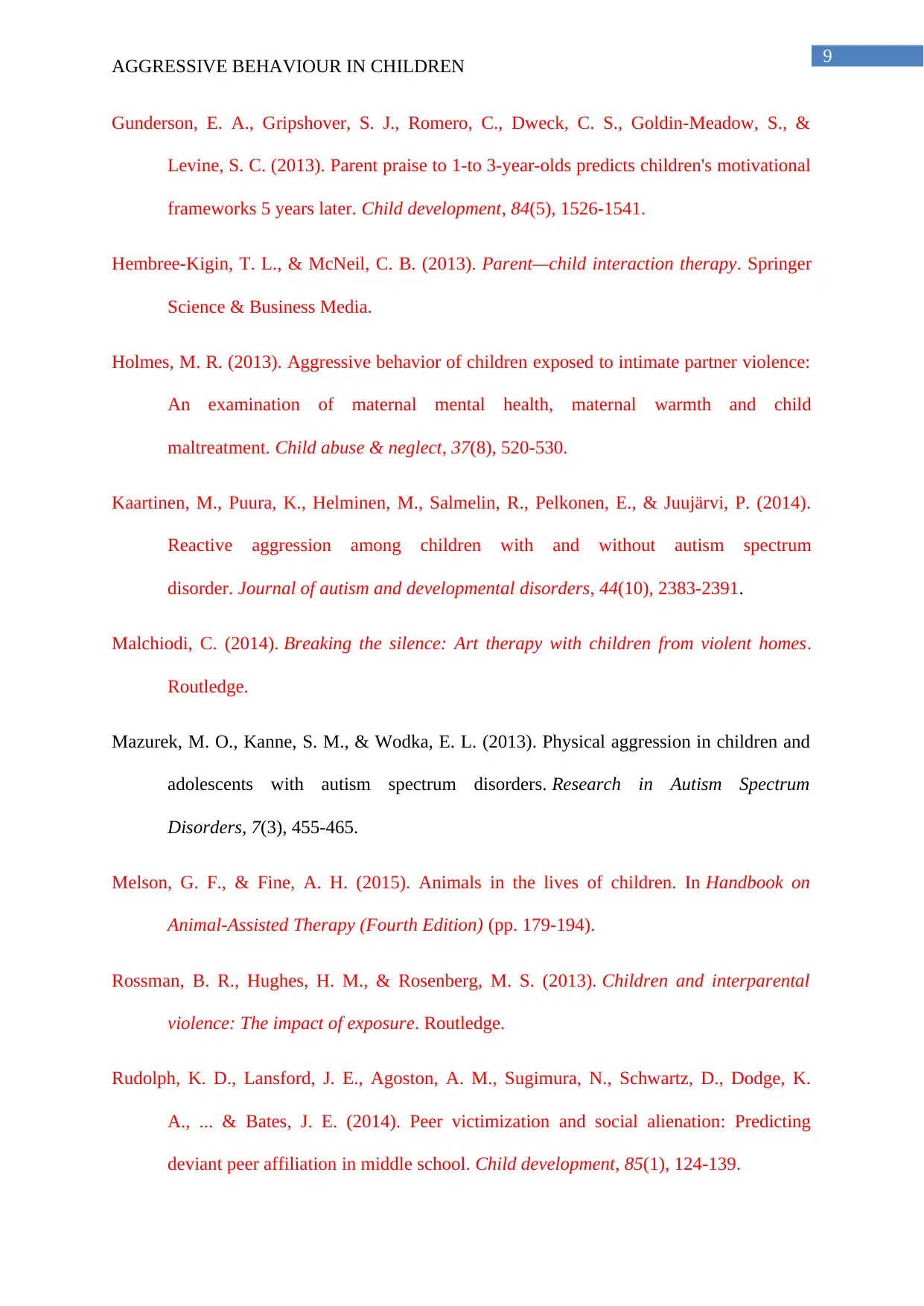
9
AGGRESSIVE BEHAVIOUR IN CHILDREN
Gunderson, E. A., Gripshover, S. J., Romero, C., Dweck, C. S., Goldin‐Meadow, S., &
Levine, S. C. (2013). Parent praise to 1‐to 3‐year‐olds predicts children's motivational
frameworks 5 years later. Child development, 84(5), 1526-1541.
Hembree-Kigin, T. L., & McNeil, C. B. (2013). Parent—child interaction therapy. Springer
Science & Business Media.
Holmes, M. R. (2013). Aggressive behavior of children exposed to intimate partner violence:
An examination of maternal mental health, maternal warmth and child
maltreatment. Child abuse & neglect, 37(8), 520-530.
Kaartinen, M., Puura, K., Helminen, M., Salmelin, R., Pelkonen, E., & Juujärvi, P. (2014).
Reactive aggression among children with and without autism spectrum
disorder. Journal of autism and developmental disorders, 44(10), 2383-2391.
Malchiodi, C. (2014). Breaking the silence: Art therapy with children from violent homes.
Routledge.
Mazurek, M. O., Kanne, S. M., & Wodka, E. L. (2013). Physical aggression in children and
adolescents with autism spectrum disorders. Research in Autism Spectrum
Disorders, 7(3), 455-465.
Melson, G. F., & Fine, A. H. (2015). Animals in the lives of children. In Handbook on
Animal-Assisted Therapy (Fourth Edition) (pp. 179-194).
Rossman, B. R., Hughes, H. M., & Rosenberg, M. S. (2013). Children and interparental
violence: The impact of exposure. Routledge.
Rudolph, K. D., Lansford, J. E., Agoston, A. M., Sugimura, N., Schwartz, D., Dodge, K.
A., ... & Bates, J. E. (2014). Peer victimization and social alienation: Predicting
deviant peer affiliation in middle school. Child development, 85(1), 124-139.
AGGRESSIVE BEHAVIOUR IN CHILDREN
Gunderson, E. A., Gripshover, S. J., Romero, C., Dweck, C. S., Goldin‐Meadow, S., &
Levine, S. C. (2013). Parent praise to 1‐to 3‐year‐olds predicts children's motivational
frameworks 5 years later. Child development, 84(5), 1526-1541.
Hembree-Kigin, T. L., & McNeil, C. B. (2013). Parent—child interaction therapy. Springer
Science & Business Media.
Holmes, M. R. (2013). Aggressive behavior of children exposed to intimate partner violence:
An examination of maternal mental health, maternal warmth and child
maltreatment. Child abuse & neglect, 37(8), 520-530.
Kaartinen, M., Puura, K., Helminen, M., Salmelin, R., Pelkonen, E., & Juujärvi, P. (2014).
Reactive aggression among children with and without autism spectrum
disorder. Journal of autism and developmental disorders, 44(10), 2383-2391.
Malchiodi, C. (2014). Breaking the silence: Art therapy with children from violent homes.
Routledge.
Mazurek, M. O., Kanne, S. M., & Wodka, E. L. (2013). Physical aggression in children and
adolescents with autism spectrum disorders. Research in Autism Spectrum
Disorders, 7(3), 455-465.
Melson, G. F., & Fine, A. H. (2015). Animals in the lives of children. In Handbook on
Animal-Assisted Therapy (Fourth Edition) (pp. 179-194).
Rossman, B. R., Hughes, H. M., & Rosenberg, M. S. (2013). Children and interparental
violence: The impact of exposure. Routledge.
Rudolph, K. D., Lansford, J. E., Agoston, A. M., Sugimura, N., Schwartz, D., Dodge, K.
A., ... & Bates, J. E. (2014). Peer victimization and social alienation: Predicting
deviant peer affiliation in middle school. Child development, 85(1), 124-139.
Paraphrase This Document
Need a fresh take? Get an instant paraphrase of this document with our AI Paraphraser
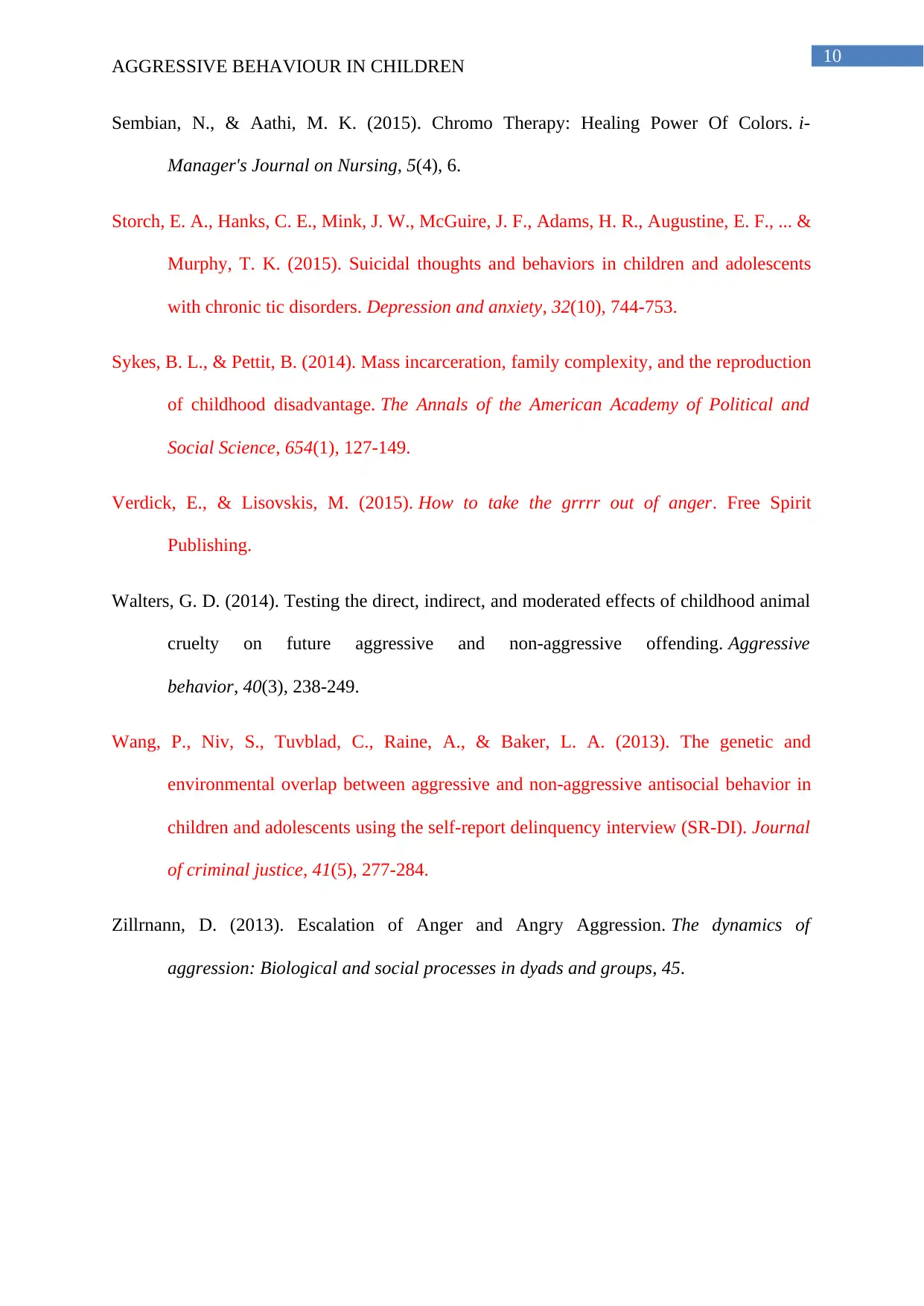
10
AGGRESSIVE BEHAVIOUR IN CHILDREN
Sembian, N., & Aathi, M. K. (2015). Chromo Therapy: Healing Power Of Colors. i-
Manager's Journal on Nursing, 5(4), 6.
Storch, E. A., Hanks, C. E., Mink, J. W., McGuire, J. F., Adams, H. R., Augustine, E. F., ... &
Murphy, T. K. (2015). Suicidal thoughts and behaviors in children and adolescents
with chronic tic disorders. Depression and anxiety, 32(10), 744-753.
Sykes, B. L., & Pettit, B. (2014). Mass incarceration, family complexity, and the reproduction
of childhood disadvantage. The Annals of the American Academy of Political and
Social Science, 654(1), 127-149.
Verdick, E., & Lisovskis, M. (2015). How to take the grrrr out of anger. Free Spirit
Publishing.
Walters, G. D. (2014). Testing the direct, indirect, and moderated effects of childhood animal
cruelty on future aggressive and non‐aggressive offending. Aggressive
behavior, 40(3), 238-249.
Wang, P., Niv, S., Tuvblad, C., Raine, A., & Baker, L. A. (2013). The genetic and
environmental overlap between aggressive and non-aggressive antisocial behavior in
children and adolescents using the self-report delinquency interview (SR-DI). Journal
of criminal justice, 41(5), 277-284.
Zillrnann, D. (2013). Escalation of Anger and Angry Aggression. The dynamics of
aggression: Biological and social processes in dyads and groups, 45.
AGGRESSIVE BEHAVIOUR IN CHILDREN
Sembian, N., & Aathi, M. K. (2015). Chromo Therapy: Healing Power Of Colors. i-
Manager's Journal on Nursing, 5(4), 6.
Storch, E. A., Hanks, C. E., Mink, J. W., McGuire, J. F., Adams, H. R., Augustine, E. F., ... &
Murphy, T. K. (2015). Suicidal thoughts and behaviors in children and adolescents
with chronic tic disorders. Depression and anxiety, 32(10), 744-753.
Sykes, B. L., & Pettit, B. (2014). Mass incarceration, family complexity, and the reproduction
of childhood disadvantage. The Annals of the American Academy of Political and
Social Science, 654(1), 127-149.
Verdick, E., & Lisovskis, M. (2015). How to take the grrrr out of anger. Free Spirit
Publishing.
Walters, G. D. (2014). Testing the direct, indirect, and moderated effects of childhood animal
cruelty on future aggressive and non‐aggressive offending. Aggressive
behavior, 40(3), 238-249.
Wang, P., Niv, S., Tuvblad, C., Raine, A., & Baker, L. A. (2013). The genetic and
environmental overlap between aggressive and non-aggressive antisocial behavior in
children and adolescents using the self-report delinquency interview (SR-DI). Journal
of criminal justice, 41(5), 277-284.
Zillrnann, D. (2013). Escalation of Anger and Angry Aggression. The dynamics of
aggression: Biological and social processes in dyads and groups, 45.
1 out of 11
Related Documents
Your All-in-One AI-Powered Toolkit for Academic Success.
+13062052269
info@desklib.com
Available 24*7 on WhatsApp / Email
![[object Object]](/_next/static/media/star-bottom.7253800d.svg)
Unlock your academic potential
Copyright © 2020–2025 A2Z Services. All Rights Reserved. Developed and managed by ZUCOL.




